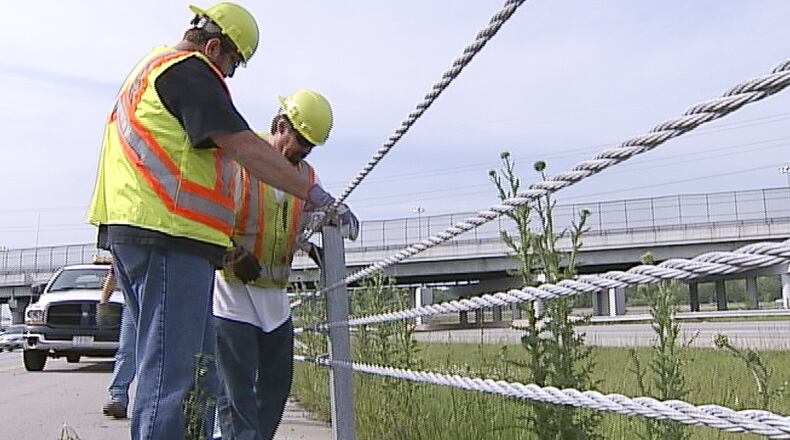“It is staggering to guess what percentage of severe crashes would have been caused if all vehicles in these crash events were able to cross through the median and reach opposing travel lanes, which increases the probability of being involved in head-on type of crashes,” the UD researchers Deogratias Eustace and Mohammad Almothaffar wrote in their study.
MORE: Ohio State Highway Patrol has new crash data tool for residents
A Federal Highway Administration analysis of crash data from 2014 to 2016 showed more than half of all fatalities — 53% — were the result of cross-median crashes.
The UD study found about 95% of vehicles in crashes did not breach cable barriers while 2.9% breached the barriers but did not cross into oncoming traffic.
“The intention of putting up those barriers was to prevent the most dangerous type of crashes. I think the barriers have performed as expected,” said Eustace, director of the UD Transportation Engineering Lab.
The study also showed barriers stopped motorcycles 100% of the time, passenger cars 96.5% of the time, light trucks 95.5% of the time, medium trucks 88% of the time and heavy trucks 85.9% of the time.
A cable barrier was not enough to prevent the driver of a semi tractor trailer from crossing an I-75 median in Moraine, resulting in a February crash that killed three members of a Middletown family.
MORE: I-75 triple fatal: Do cable barriers stop highway crashes?
Ohio started installing along highway medians narrower than 59 feet in 2003, but no rigorous analysis of their effectiveness had been done until the UD researchers pored over years of crash data before and after the safety cables were installed, said Eustace, also an associate professor of engineering.
The Ohio Department of Transportation provided the researchers with 41 interstate locations where median cable barriers have been installed since 2010. From those, Almothaffar and Eustace selected 14 locations that had three years of crash data available prior to cable barrier installation.
The researchers calculated the safety effectiveness of Ohio’s statewide cable barriers at 73.9% for all crashes, 80.4% for fatal and injury crashes combined and 80.1% for fatal, incapacitating and non-incapacitating injury crashes combined.
Study sites located within the region included I-675 in Greene and Montgomery counties, I-75 in Miami County and I-70 in Montgomery County. The local sites all had five years of crash data available for analysis after the installation of cables.
The study completed in 2018 formed the backbone of Almothaffar’s master’s thesis. It was presented last October at a transportation conference in Columbus and the university released the report in June as coronavirus lockdowns were lifted and more people returned to highways.
MORE: Coronavirus: Traffic drops, roads empty as virus keeps Ohioans home
Ohio traffic fatalities are down 33% this year compared to the same period in 2019. Ohio State Highway Patrol statistics show 423 people have died in 2020 vehicle crashes as of Monday; 456 fatalities were recording by the same date last year.
The UD researchers discovered cable barriers in use as early as the 1930s. A new system developed in the 1960s pushed the safety measure into broader use.
Ohio had 406 miles of cable barrier when Almothaffar and Eustace began their study. The state now has 315 miles of cable barrier. Cables in some locations have been replaced by concrete barriers as roadways are widened into previous median areas, according to ODOT.
MORE: State slow to repair broken I-675 cables
Cable barrier costs about $155,000 per mile to install but has proven a lifesaver, said Matt Bruning, an ODOT spokesman.
An ODOT analysis found that cable barriers reduced cross-median crashes by 91%, fatalities by 83% and serious injuries by 98%.
“We believe it is an effective tool in helping to reduce the number of cross-median crashes which tend to be serious or deadly,” Bruning said. “We don’t want to see any crashes in Ohio, but if we do, we’d prefer they be crashes that those involved can walk away from.”
MORE: Patrol: More people driving 100-plus mph on Ohio roadways as overall tickets plummet
While more serious and often deadly head-on crashes have been reduced, cable barriers are not consequence-free, Eustace said. Drivers who leave the roadway and might otherwise come to safe stop in the median are nearly assured at least minor vehicle damage by striking a cable.
The barriers can also be a hinderance to first responders when an incident occurs on both sides of a freeway. The cable tension can also become a weapon if another vehicle strikes the cable near emergency workers, according to the study.
Despite some reservations by emergency first responders, police, fire and medic personnel polled by the UD researchers revealed that more than 75% agreed that cable barriers have enhanced safety on Ohio’s freeways. Fewer than 8% disagreed.
Still, cable barriers are more forgiving in a crash than concrete barriers and less expensive, Eustace said.
ODOT maintains 19,229 miles of roadway in the state, of which 772 miles is protected by concrete barriers, according to the transportation department, which estimates each mile of concrete barrier costs $595,000 to construct.
Cable barrier effectiveness on Ohio freeways
University of Dayton researchers analyzed 2,209 crashes where cable barriers were installed on Ohio highways. Here’s how effective the barriers were at preventing cross-over collisions in those crashes.
95.4% - Vehicle did not breach barrier
2.9% - Vehicle breached barrier but was contained in median
1.7% - Vehicle breached barrier and entered opposing lanes
Percentage of crashes stopped by vehicle type
100% - Motorcycles
96.5% - Passenger cars
95.5% - Light trucks
88% - Medium trucks
85.9% - Heavy trucks
Source: University of Dayton Transportation Engineering Lab
About the Author

